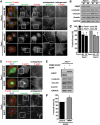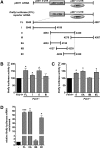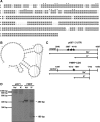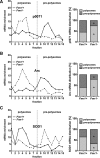FMRP regulates actin filament organization via the armadillo protein p0071
- PMID: 24062571
- PMCID: PMC3851716
- DOI: 10.1261/rna.037945.112
FMRP regulates actin filament organization via the armadillo protein p0071
Abstract
Loss of fragile X mental retardation protein (FMRP) causes synaptic dysfunction and intellectual disability. FMRP is an RNA-binding protein that controls the translation or turnover of a subset of mRNAs. Identifying these target transcripts is an important step toward understanding the pathology of the disease. Here, we show that FMRP regulates actin organization and neurite outgrowth via the armadillo protein p0071. In mouse embryonic fibroblasts (MEFs) lacking FMRP (Fmr1-), the actin cytoskeleton was markedly reorganized with reduced stress fibers and F-actin/G-actin ratios compared to fibroblasts re-expressing the protein. FMRP interfered with the translation of the p0071 mRNA in a 3'-UTR-dependent manner. Accordingly, FMRP-depleted cells revealed elevated levels of p0071 protein. The knockdown of p0071 in Fmr1- fibroblasts restored stress fibers and an elongated cell shape, thus rescuing the Fmr1- phenotype, whereas overexpression of p0071 in Fmr1+ cells mimicked the Fmr1- phenotype. Moreover, p0071 and FMRP regulated neurite outgrowth and branching in a diametrically opposed way in agreement with the negative regulation of p0071 by FMRP. These results identify p0071 as an important and novel FMRP target and strongly suggest that impaired actin cytoskeletal functions mediated by an excess of p0071 are key aspects underlying the fragile X syndrome.
Keywords: FMRP; actin organization; dendrite formation; neuromorphogenesis; p0071.
Figures









Similar articles
-
Transport of fragile X mental retardation protein via granules in neurites of PC12 cells.Mol Cell Biol. 2002 Dec;22(23):8332-41. doi: 10.1128/MCB.22.23.8332-8341.2002. Mol Cell Biol. 2002. PMID: 12417734 Free PMC article.
-
Fragile X-like behaviors and abnormal cortical dendritic spines in cytoplasmic FMR1-interacting protein 2-mutant mice.Hum Mol Genet. 2015 Apr 1;24(7):1813-23. doi: 10.1093/hmg/ddu595. Epub 2014 Nov 28. Hum Mol Genet. 2015. PMID: 25432536 Free PMC article.
-
The RNA-binding protein FMRP facilitates the nuclear export of N6-methyladenosine-containing mRNAs.J Biol Chem. 2019 Dec 27;294(52):19889-19895. doi: 10.1074/jbc.AC119.010078. Epub 2019 Nov 21. J Biol Chem. 2019. PMID: 31753916 Free PMC article.
-
Fragile X syndrome: loss of local mRNA regulation alters synaptic development and function.Neuron. 2008 Oct 23;60(2):201-14. doi: 10.1016/j.neuron.2008.10.004. Neuron. 2008. PMID: 18957214 Free PMC article. Review.
-
Molecular insights into mental retardation: multiple functions for the Fragile X mental retardation protein?Curr Issues Mol Biol. 2004 Jul;6(2):73-88. Curr Issues Mol Biol. 2004. PMID: 15119819 Review.
Cited by
-
Axonal and presynaptic FMRP: Localization, signal, and functional implications.Hear Res. 2023 Mar 15;430:108720. doi: 10.1016/j.heares.2023.108720. Epub 2023 Feb 11. Hear Res. 2023. PMID: 36809742 Free PMC article. Review.
-
CYFIP family proteins between autism and intellectual disability: links with Fragile X syndrome.Front Cell Neurosci. 2014 Mar 27;8:81. doi: 10.3389/fncel.2014.00081. eCollection 2014. Front Cell Neurosci. 2014. PMID: 24733999 Free PMC article. Review.
-
A genomics approach identifies selective effects of trans-resveratrol in cerebral cortex neuron and glia gene expression.PLoS One. 2017 Apr 25;12(4):e0176067. doi: 10.1371/journal.pone.0176067. eCollection 2017. PLoS One. 2017. PMID: 28441400 Free PMC article.
-
The FMRP-MOV10 complex: a translational regulatory switch modulated by G-Quadruplexes.Nucleic Acids Res. 2020 Jan 24;48(2):862-878. doi: 10.1093/nar/gkz1092. Nucleic Acids Res. 2020. PMID: 31740951 Free PMC article.
-
FXR1 regulates vascular smooth muscle cell cytoskeleton, VSMC contractility, and blood pressure by multiple mechanisms.Cell Rep. 2023 Apr 25;42(4):112381. doi: 10.1016/j.celrep.2023.112381. Epub 2023 Apr 11. Cell Rep. 2023. PMID: 37043351 Free PMC article.
References
-
- Anastasiadis PZ, Reynolds AB 2001. Regulation of Rho GTPases by p120-catenin. Curr Opin Cell Biol 13: 604–610 - PubMed
Publication types
MeSH terms
Substances
LinkOut - more resources
Full Text Sources
Other Literature Sources
Molecular Biology Databases
Research Materials
